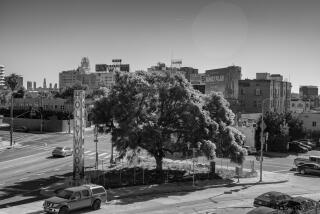Shear Madness : As More and More Hedges Get Cut Back, Life in the City Gets a Little Drearier
- Share via
One thing that makes American life a little bleaker than life in Europe, I think, is a lack of hedges. Oh, we have a few here and there, but they’re not nearly as profuse as they are in, say, England.
No, here one has to seek out hedges, catch them as one can in our ever more urban landscapes. Perhaps that is why I have settled happily in Pasadena, where hedges are still at home, where it’s not uncommon to see three or four of them flourishing on one block.
Exactly what a hedge is is a matter of opinion. It need not be a trained or well-clipped evergreen specimen. It can be a bush that has simply become careless about its appearance or enlarged itself into downright sloppiness. It could even be ivy that has taken the opportunity, as ivy always will, to overrun weaker vegetation. Nor are raspberry bushes any slouches in the hedge department. Or perhaps morning glories or growths of some other pleasant weed have decided to overtake the picket fence and run around on the other side. It was heartening to come across just such a one the other day in the heartland of Los Angeles at a corner of Rodney Drive and Melbourne Avenue. I’m afraid some overly proper property owner will make trimming it back his first order of business and ruin it.
Meanwhile, over in England, they are doing something about hedges--doing what people always do before demolishing valued things: researching, making historical surveys and mapping them.
A Mr. Alan Spicer has spent 10 years doing just that in the parish of Charlbury. An 1895 map that he found showed about 270 hedgerows; now more than 100 are gone. Max Hooper of the Institute of Terrestrial Ecology theorized that a new species of plant takes root in a hedge only every 100 years; hence, a hedge made up of 10 species would be 1,000 years old. Spicer has found 500-year-old hedges in his parish.
As early as 1845, the Royal Agricultural Society called for the “reduction or abolition of hedges.” Today, it’s easier to farm without hedges; a tractor can more easily run over open ground than it can stop and go around a hedge.
But others--not farmers but wealthy weekenders in England--are “laying” new hedges here and there. Hedge plants have to have their stems bent to the ground and then be woven along hazel stakes, as if they were giant, growing baskets. It’s hard work, slow and expensive.
Dog rose, ash, hawthorn, purging buckthorn, wayfaring trees--the names of English hedge plants are lovely and romantic. But maybe here in California, yew, holly, boxwood, even poinsettia could, if given a little encouragement, still raise high our American hopes for hedges.






